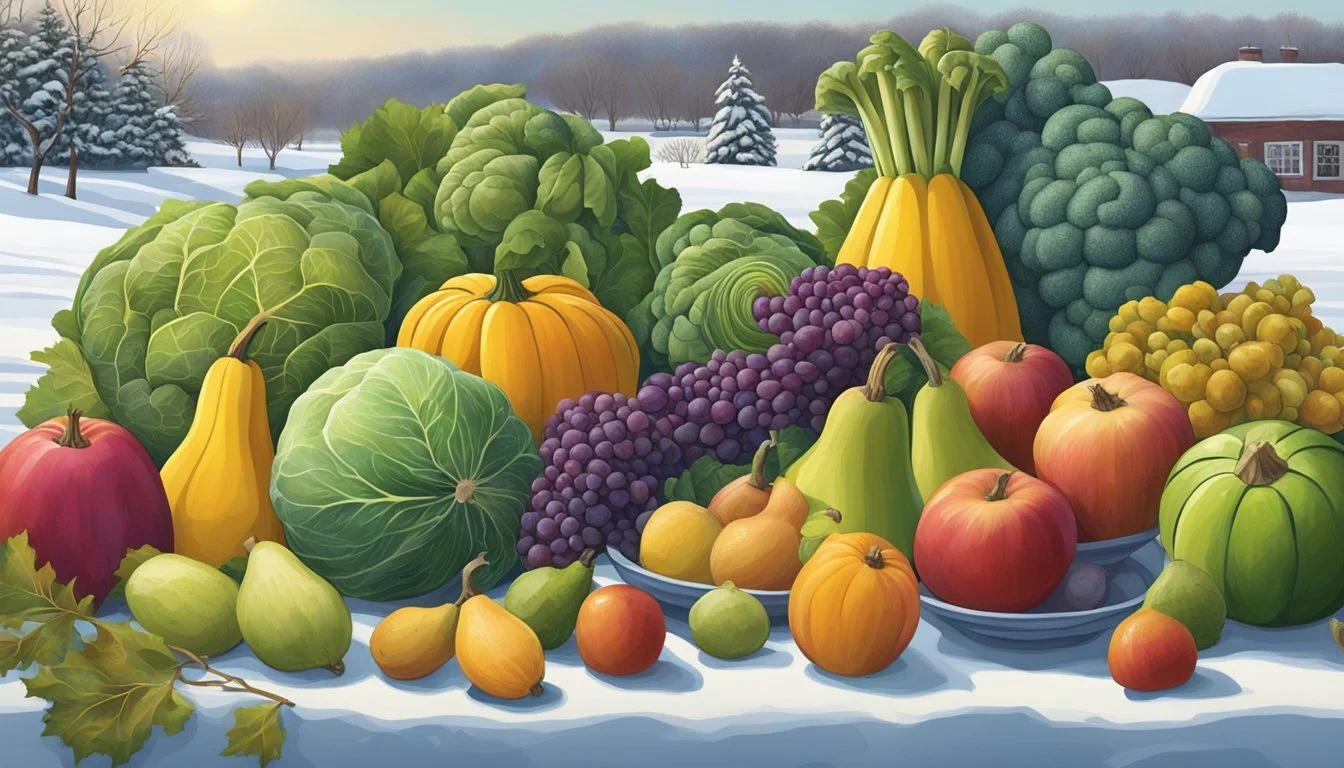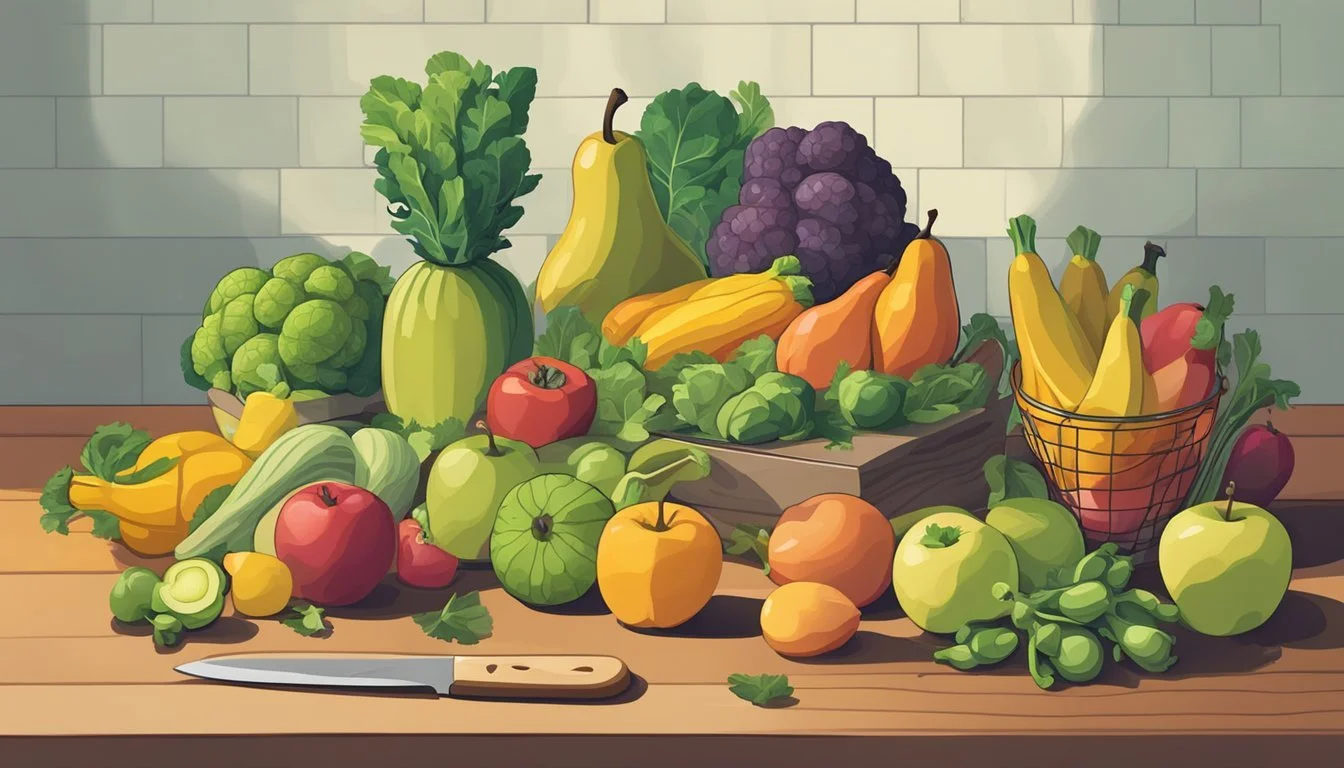Illinois Seasonal Fruit & Vegetables in December
A Guide to Winter Produce
This Article is Part of our Illinois Seasonal Fruit & Veg Calendar
Winter in Illinois brings a shift in the local produce selection available to consumers. December, in particular, sees fewer varieties of fruits and vegetables due to the frosty conditions. However, this does not mean the absence of fresh options. The state's farmers and markets still offer a range of seasonal produce that not only supports local agriculture but also provides nutritional benefits during the colder months.
Despite the chill, there are select fruits and vegetables that thrive in December in Illinois. Root vegetables, such as turnips and parsnips, maintain their quality in the ground even through frosts, while cold storage extends the availability of fall-harvested produce like apples and winter squash. Furthermore, greenhouse cultivation and indoor farming techniques help to supply items like leafy greens, which might otherwise be unavailable until spring. Consumers prioritize these seasonal items for their peak freshness and flavor, aligning with a growing interest in sustainable eating habits and support for regional producers.
Understanding Illinois Seasonality
In Illinois, the seasonality of produce is dictated by local climate patterns and the natural growing season. Consumers can expect shifts in availability and freshness of fruits and vegetables as the seasons change.
Defining Seasonal Eating
Seasonal eating in Illinois means consuming fruits and vegetables at the time of year when they are naturally harvested. The growing season typically ranges from spring to fall, with December marking a period where there are fewer fresh local produce options due to colder weather.
Benefits of Seasonal Consumption
Eating seasonally provides multiple benefits:
Freshness: Produce is at its peak in flavor and nutrition.
Support for local farmers: Buying seasonal crops helps support the regional economy.
Environmental impact: Seasonal consumption often means reduced transportation and storage, leading to lower carbon emissions.
In December, the typical crops available may include winter storage vegetables and some greenhouse-grown produce, reflecting the adaptability of Illinois farmers to extend the harvest times within the constraints of the season.
Seasonal Fruits in December
In December, Illinois residents enjoy a modest selection of fresh fruits, owing to the state's colder climate. At this time of year, apples stand out as a versatile choice for both fresh eating and cooking. Varieties such as the Pink Lady and Fuji maintain good texture and flavor and are readily available.
Pears are another hearty fruit that can withstand the chilly weather—look for Anjou or Bosc pears, known for their firmness and sweet taste.
Persimmons, particularly the native American persimmon, come into season in late fall and can extend into the winter months. These sweet, slightly tangy fruits are often found at local markets and are perfect for both desserts and savory dishes.
While not as commonly associated with December, cranberries are still part of the seasonal produce palette. Fresh cranberries, harvested in the fall, can typically be found well into December due to their storage capability. They're ideal for making sauces, jellies, or adding a tart component to baked goods.
Fruit Description Uses Apples Firm, sweet Fresh, pies, sauces Pears Sweet, juicy Fresh, baking, poaching Persimmons Tangy, sweet Puddings, cookies, salads Cranberries Tart, firm Sauces, jellies, baking
One can often find these fruits incorporated into seasonal dishes, celebrating the tastes of winter in Illinois. They include the state's agricultural bounty in farmers' markets and grocery stores, reaffirming the significance of seasonal eating.
Seasonal Vegetables in December
In December, Illinois offers a diverse range of vegetables that thrive in the colder climate. Root vegetables and members of the brassica family are particularly abundant during this time.
Root Vegetables:
Sweet Potatoes: Nutrient-rich, offering a sweet, earthy flavor ideal for a variety of dishes.
Turnips: Known for their white flesh, they are versatile in cooking.
Beets (how long do beets last?): Deep red and packed with vitamins, they are suitable for salads or roasting.
Celeriac/Celery Root: With a taste similar to celery, celeriac can be used in soups or as a roasted side.
Parsnips: Resembling carrots, they have a sweeter taste and are excellent when roasted.
Brassicas:
Broccoli: Known for its health benefits, it can be eaten raw or cooked.
Brussels Sprouts: They bear a nutty flavor and gain sweetness when roasted.
Cabbage: Great in slaws or cooked dishes, adds crunch and flavor.
Cauliflower: Versatile in cooking, it can be steamed, roasted, or riced.
Alliums & Others:
Leeks: Subtle onion-like flavor, ideal for stocks and soups.
Onions and Garlic: Essential flavor bases for a multitude of recipes.
Fennel (how long does fennel last?): With a slight anise flavor, it is crisp and can be used raw or cooked.
Leafy Greens:
Kale: Sturdy leaves, suited for chips or stews.
Spinach and Chard: Tender and fast-cooking, ideal for salads or sautés.
Greens: Collards and mustard greens are also in season, perfect for hearty dishes.
Winter Squash:
Varieties like butternut or acorn offer sweet flesh that is excellent for soups or as roasted sides.
These vegetables are not only fresh and flavorful in December but also support local agriculture and sustainable eating habits. Consumers can explore these seasonal offerings to create nutritious and hearty winter meals.
Culinary Uses and Tips
In December, Illinois seasonal produce lends itself to a variety of culinary applications, from vibrant salads to hearty soups. Utilizing fresh, in-season ingredients can elevate the flavor and nutritional value of winter meals.
Incorporating December Produce into Meals
Citrus fruits like clementines, oranges, and grapefruits, available in December, provide a refreshing zing to both sweet and savory dishes. Salads gain a burst of flavor and color with segments of these fruits, while smoothies benefit from their vitamin-rich juices.
One can also experience the versatility of root vegetables such as celeriac and rutabagas during this season. These ingredients form the backbone of nourishing soups. Whether it’s a celeriac soup pureed to silky perfection or rutabagas added to hearty stews, these root vegetables are essential for cooking robust winter dishes.
Winter greens, like kale and chard, can be sautéed or roasted to complement proteins, or they can be chopped fresh into crisp salads. Adding pomegranate seeds (how long do pomegranate seeds last?) to a kale salad introduces a sweet-tart crunch, while chard can transform a simple quiche (What wine goes well with quiche?) into a festive, flavorful meal.
Preservation Methods for Winter
With colder months restricting produce availability, preservation techniques become key for extending the life of December's bounty. One can pickle beets and cabbages, turning them into tangy additions for sandwiches and salads. Freezing citrus fruits in segments or as fresh juice ensures a steady supply for recipes throughout the winter.
Proper storage of potatoes and onions in a cool, dark place aids in maintaining their quality over time, making them staple ingredients for various dishes throughout the season. Herbs, such as cilantro, can be finely chopped and mixed with oil or water, then frozen in ice cube trays for later use in cooking.
By harnessing the flavors of December’s harvest and employing preservation strategies, chefs and home cooks can create palate-pleasing dishes that showcase the best of winter's offerings.
Buying and Storing Seasonal Produce
When purchasing seasonal produce in Illinois during December, consumers should consider the quality and storage practices to maintain freshness. Proper selection and storage can significantly enhance the longevity and taste of fruits and vegetables.
Selecting the Best Produce
When shopping at markets or stores, one should look for fruits that are slightly firm, without any visible blemish or signs of spoilage. Vegetables should be vibrant in color and firm to the touch. For roots and tubers, which are common in December, the skin should be intact without any cuts or soft spots. Fruits that are harvested in winter, like apples, may not be as sweet as they are in the fall, yet they still provide a rich, full flavor when consumed raw or cooked.
Storage Techniques for Freshness
Fruits: To ensure fruits remain fresh and possibly become sweeter, store them at room temperature away from direct sunlight until they achieve the desired ripeness. Once ripe, refrigeration can help maintain sweetness and prevent spoilage. Apples, for example, can be refrigerated in a plastic bag with holes for air circulation.
Soft fruits: Store in a single layer, avoiding overcrowding which leads to quicker spoilage.
Apples: Best stored in the crisper drawer of the refrigerator.
Vegetables: Most winter vegetables benefit from being stored in a cold and slightly humid environment. Root vegetables like carrots and beets can be stored in the refrigerator, preferably in the crisper drawer.
Leafy greens: Wrap in a damp paper towel and store in a container.
Root vegetables: Place in a perforated plastic bag in the crisper drawer.
By following these simple yet effective practices, the quality of seasonal produce can be maintained.
Supporting Local Agriculture
In Illinois, the importance of supporting local agriculture, especially family-owned farms, extends well beyond traditional economic benefits; it strengthens community bonds and ensures the availability of fresh, seasonal produce. Exploring local farms and participating in CSA programs are two critical avenues for consumers to engage with and sustain Illinois's vibrant agricultural ecosystem.
Finding Local Farms and Produce
Consumers can locate family-run farms throughout Illinois by utilizing resources like local farmers' markets and online directories. These platforms enable individuals to purchase fresh December produce, typically including items such as winter squash, apples, and root vegetables. Here is a list of specific produce Illinoisans might find in December:
Apples
Beets
Carrots
Potatoes
Winter squash
Seeking out these farms not only provides access to nutritious, seasonal food but also fosters a direct relationship with the growers, promoting a deeper understanding of where and how food is produced.
Community Supported Agriculture (CSA)
Community Supported Agriculture, commonly known as CSA, involves consumers buying "shares" of produce directly from local farms. In Illinois, this model has been thriving for over 25 years. Here's how it works:
Farmers offer shares: This generally includes a weekly or monthly box of vegetables and may also comprise other farm products.
Consumers purchase shares: This upfront investment helps to cover the production costs of the farm.
Regular distribution: Shareholders receive a portion of seasonal produce throughout the farming season, which may extend into December featuring cold-hardy crops.
Participating in a CSA program is a tangible way to commit to healthy eating while ensuring the sustainability of local farms.








